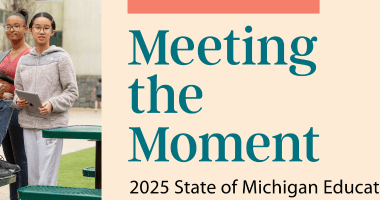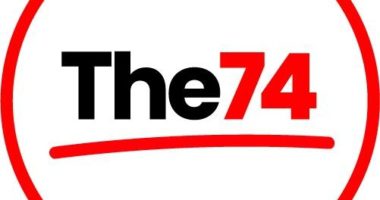Opinion: 5 education issues to watch in Michigan in 2024
This opinion piece appeared in Crain’s Detroit Business by Education Trust-Midwest’s Executive Director Amber Arellano and Director of Government Affairs Jeff Cobb.
For too long, Michigan has trailed leading education states, and the COVID-19 pandemic exacerbated our inequities in education. Yet 2023 brought hope for the future as policymakers increasingly demonstrated their commitment to improving teaching and learning, including through Gov. Whitmer’s Growing Michigan Together Council, which in December made key recommendations to strengthen Michigan’s public education system and ensure the state has a thriving workforce for decades to come.
The year ahead is critical for addressing Michigan’s most pressing education challenges. These are key issues to prioritize in 2024.
Educational recovery must be top priority
The pandemic brought devastating challenges for students across the nation, particularly from low-income, rural and urban backgrounds, Black and Latino students, English Learners and students with disabilities. Progress on the most recent state assessments show students are still behind pre-pandemic levels, with some students losing over a year of learning.
Indeed, recent M-STEP scores showed our students remain behind pre-pandemic levels in grades 3-7 in English Language Arts. And as The Education Trust-Midwest reported last year, Michigan fell from 32nd in 2019 to 43rd in 4th grade reading – an important predictor of a child’s future academic success and life outcomes – on the 2022 National Assessment for Educational Progress (NAEP). For students from low-income backgrounds, Michigan ranked as the 11th worst state in 4th grade reading, falling far below the national average. For Black student performance, Michigan dropped into the bottom 5 for 4th grade reading in 2022, down from previously being ranked in the bottom 10 in 2019.
Learning recovery isn’t over. Indeed, it is just beginning. Michigan policymakers and practitioners should prioritize and invest with urgency in educational recovery and evaluate programs for their effectiveness in closing gaps.
Preparations for a looming federal funding cliff
2024 marks the final year in which districts can spend the federal relief funding that was earmarked to help students recover from the COVID-19 pandemic. In September, the end of this needed funding will leave many districts in a precarious place. State and national data show educators continue to face multiple post-pandemic crises, including in raising student achievement, student attendance and mental health.
In fact, without additional state investments, district budgets could be slashed by an average of $1,200 per student in the 2024-25 school year through a combination of declining enrollment and the end of the Elementary and Secondary Emergency School Relief (ESSER) funds, according to a recent brief by The Education Trust.
That loss of funding will be felt most acutely in Michigan’s higher-poverty districts, many of which have been depending on the funding to support critical needs. Last year Michigan policymakers made an historic step that will help districts, especially those who serve higher percentages of students with the greatest needs, through the passage of the state’s Opportunity Index. This historic change in the state’s school funding formula means that Michigan will for the first-time consider for concentration of poverty in school districts, which will help drive additional funding to students from low-income backgrounds to meet their needs. The creation of the Opportunity Index is a significant step forward for Michigan, but it’s certainly not enough. The state continues to trail leading education states such as Massachusetts, which invests far more in students with the greatest needs — and has far better student outcomes across key measures.
Indeed, only transformational and historic changes in how schools are funded will fill the gap. Currently, the Opportunity Index is a weighted funding formula enshrined in law that invests up to 47% more for students in districts with the highest concentrations of poverty, but the state has not committed to fully fund that amount. We should change that. Let’s commit to protecting and fully funding the Opportunity Index, as recommended by the Governor’s Council, while also increasing funding for English Learners and providing full funding to support the needs of students with disabilities.
Strong fiscal transparency and accountability needed
As important as the ESSER dollars have been, many stakeholders have been frustrated by a lack of transparency and accountability for this crucial spending to help students catch up. Along with considering a school funding formula that is far more equitable, Michigan policymakers should design systems to ensure that dollars intended for students who are underserved actually reach them in their schools and classrooms. Michigan lacks such a system now.
California demonstrates the importance of and need for such a new system. A decade ago, California laudably changed its school funding formula to dramatically increase investments in education but did not put appropriate systems in place to track whether dollars were being spent on students with high needs. Tragically, auditors have found that on average only 55 cents of every dollar earmarked for students with the greatest needs was actually reaching their schools.
Michigan can learn from those lessons before it’s too late. Putting new systems of accountability and transparency in place for school funding should be a priority for our state leaders in the coming year.
Improving early literacy should be a priority
Being successful in reading in the early grades is a major predictor for academic success for students later in school, and yet too many of our students struggle to read. Indeed, Michigan was facing an early reading crisis even before COVID-19, with early literacy rates that were lower than they were almost 20 years ago, according to the national assessment.
Our state has a tremendous opportunity to change this trajectory. We can start by passing bi-partisan legislation to screen for dyslexia, one of the most common barriers to early reading success. Senate Bills 567 and 568 would strengthen the state’s Read by Grade Three Law by improving how schools screen and identify students that need support.
Among other improvements, these bills would require schools to use valid and reliable screening assessments to identify and monitor early elementary students who struggle with decoding and word recognition and use a multi-tiered system of support, which may include in targeted small groups to receive more intensive support or receive personalized instruction, to help students who display the characteristics of dyslexia. These are evidence-based strategies that our policymakers can support now to address one of Michigan’s greatest education challenges and dramatically improve outcomes for thousands of children.
Addressing teacher recruitment and shortages
Effective teachers are the single most important school-based factor to improving student outcomes, which is why Michigan’s increasingly acute teacher shortage is so concerning. Recent reports have continued to document a shortage of substitute teachers, inadequate levels of certified staff and concerning rates of mobility among teachers in some schools, especially in rural and urban districts.
Yet, we really don’t even know how serious the problem is because Michigan lacks strong systems to track educator vacancies. As with any ailment, it’s impossible to prescribe a solution without being able to diagnose the problem. That’s why Michigan should start by requiring that districts collect and publicly report teacher vacancy data.
At the same time, Michigan policymakers have a great opportunity to invest in our students by investing in their teachers. The statewide Michigan Partnership for Equity and Opportunity coalition is championing efforts to close the salary gap by raising the salary floor for teachers. This will help to recruit teachers to Michigan, as well as to hard-to-staff districts. Defraying or eliminating the costs associated with teacher licensing exams is another strategy other states are using to eliminate one of the barriers to teacher recruitment.
As our state and nation emerge from the devastating learning and other losses wrought by COVID-19, state and local leaders should redouble efforts to ensure Michigan students not only catch up but accelerate their learning. Becoming a Top 10 state for education has long been a goal of our organization and our diverse, bipartisan statewide coalition. Now, as committed leaders from across both sides of the aisle have signaled their commitment, let’s work together to address these issues and place our state on the path toward educational excellence for every child.









